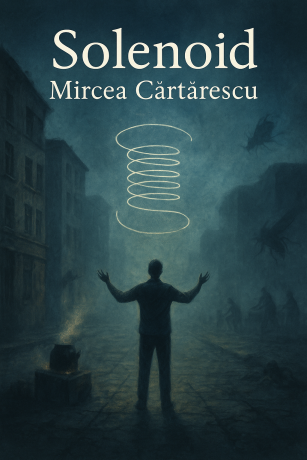Mircea Cărtărescu's Solenoid: A Surrealist Epic
BOOKS REVIEW
Chaifry
7/19/20257 min read


Mircea Cărtărescu’s Solenoid, translated into English by Sean Cotter in 2022, is a monumental work of contemporary literature, a sprawling, surrealist epic that redefines the boundaries of the novel. Set in the decaying urban landscape of late-communist Bucharest, this auto fictional odyssey follows an unnamed schoolteacher, a failed writer, as he navigates the mundane horrors of his existence while seeking transcendence through metaphysical and existential explorations. Blending surrealism, body horror, philosophy, and science fiction, Solenoid creates a labyrinthine narrative that is both deeply personal and universally resonant, challenging readers to question the nature of reality itself.
This review argues that Solenoid is an essential read for its audacious ambition, hypnotic prose, and profound engagement with the human condition. Cărtărescu’s ability to transform the everyday into the fantastical, to probe the depths of consciousness, and to explore the interplay of the corporeal and the cosmic makes this novel a transformative experience. It demands active engagement, rewarding readers with intellectual depth, emotional intensity, and poetic beauty. For those seeking literature that pushes boundaries and reshapes perceptions, Solenoid is a journey into the unknown, a text that redefines what a novel can be.
For Indian readers, it offers a unique perspective on universal themes of oppression, identity, and transcendence, resonating with India’s own historical and philosophical contexts.
Structured as the journal of an unnamed Romanian schoolteacher in the late 1970s and early 1980s, Solenoid begins with a visceral declaration: “I have lice, again. It doesn’t surprise me anymore, doesn’t disgust me. It just itches” (Cărtărescu, 2022, p. 3). This sets a tone of gritty realism that contrasts with the surreal elements that soon emerge. The narrator, living in a peculiar boat-shaped house built over a mysterious solenoid, reflects on his life as a teacher in a dilapidated Bucharest school, his failed marriage to Ștefana, his relationship with Irina, a physics teacher, and their daughter, also named Irina. His narrative weaves together childhood memories, medical traumas, and encounters with figures like Palamar, a librarian obsessed with the enigmatic Voynich Manuscript: “This manuscript is a wound in the universe, a hole through which meaning escapes” (p. 234).
The novel’s title refers to electromagnetic coils—solenoids—buried beneath Bucharest, which the narrator believes open gateways to the fourth dimension: “The solenoid is the only thing that can tear you from the world’s suffering, the only thing that can show you another world” (p. 412). His quest to escape the confines of his body and reality drives the narrative into metaphysical territory, exploring alternate dimensions, dream cults, and the microscopic world of dust mites: “The miniscule world of dust mites living on a microscope slide” (p. 472). The narrator seeks “to understand what is happening to me, what labyrinth I am in, whose test I am subject to, and how I can answer to get out whole” (p. 89), transforming Bucharest into a dreamlike city: “Bucharest, the saddest city on the face of the earth, a sea of bizarre rooves” (p. 123).
Cărtărescu’s maximalist auto fictional style blends the narrator’s life with speculative digressions on mathematics, philosophy, and existence: “My mind dressed in flesh, my flesh dressed in the cosmos” (p. 47). Recurring motifs—lice, teeth, parasites, and decaying buildings—create a sense of body horror, as seen in the narrator’s disturbing discovery: “I felt something unusual, something inorganic, not part of my body… a kind of protuberance scraping against my fingertip” (p. 49). Childhood memories, including a twin who may or may not have existed—“I don’t know if he was real or if I invented him to share my loneliness” (p. 102)—add ambiguity. The narrator’s traumatic experiences in a tuberculosis preventorium, where “the smell of penicillin, the cold, sterilized needles… a world different from the one adults inhabit” (p. 98), haunt him, while his involvement with an anti-death protest movement defies mortality: “We protest against death, against the very idea of it” (p. 567).
The novel’s climax is an apocalyptic vision of Bucharest levitating into the sky, powered by the solenoids: “The city begins to levitate, like a Marquezian character, toward the skies” (p. 638). This moment encapsulates the narrator’s rejection of literary ambition: “I am not ready to sacrifice the child I’ve had with Irina and turn my personal notes into a work of art, a novel” (p. 641). Solenoid becomes an “anti-book,” a testament to the narrator’s refusal to conform to literary expectations, yet it achieves greatness through its ambition and complexity: “I am no longer a writer, but I am alive” (p. 642). The surreal imagery of “a city floating in the void, its spires piercing the stars” (p. 639) leaves readers with a haunting vision of transcendence.
Solenoid is a triumph of literary ambition, encompassing the vastness of human experience while remaining grounded in the specificities of late-communist Romania. Cărtărescu’s prose, masterfully translated by Cotter, is hypnotic, blending the grotesque with the sublime. The opening lines— “I have lice, again. It doesn’t surprise me anymore, doesn’t disgust me. It just itches”—immerse readers in a world where the mundane is infused with visceral intensity. The translation captures the novel’s poetic cadence, particularly in passages exploring the body: “My fingers, it seems, move across not my body but my mind” (p. 47).
The journal structure creates a kaleidoscopic narrative that mirrors the narrator’s fractured psyche. Cărtărescu’s autofiction generates tension between reality and imagination, as seen in the narrator’s reflection on his failed literary career: “I drew the short straw, and my career as a writer continued, perhaps, within another possible world” (p. 156). This counterfactual approach invites readers to question success, failure, and reality itself. Bucharest is a vivid character, reflecting the narrator’s existential despair yet brimming with surreal possibility: “Bucharest seems to be a city ruined by design, an urban emblem of humanity’s grand tragedy and everlasting disappointment” (p. 123). The solenoids, described as “copper coils with mysterious properties” (p. 204), symbolize the quest for transcendence, making Solenoid a profound meditation on existence.
The novel’s engagement with literary influences—Kafka, Borges, García Márquez, and Proust—enriches its texture. The narrator’s reflections on literature, such as “I don’t believe in books—I believe in pages, in phrases, in lines” (p. 16), underscore its self-reflexive nature, positioning Solenoid as both a critique and a celebration of literary ambition.
Solenoid’s length—over 600 pages—can be daunting, and some sections feel repetitive. The narrator’s fixation on parasites and bodily decay, while thematically rich, can overwhelm, as in the passage describing dust mites: “The miniscule world of dust mites living on a microscope slide” (p. 472). These digressions occasionally disrupt narrative momentum. The masculine perspective is another limitation, with descriptions like “At this moment I looked at her vulva with a kind of indifference” (p. 389) reflecting a detached gaze that may alienate readers. The dense philosophical and scientific digressions, such as those on the fourth dimension, can be challenging, and the narrator’s solipsistic tone— “a sweeping solipsism that makes of paranoia a kind of totalizing faith” (p. 312)—may feel isolating.
The novel’s strengths shine in the narrator’s description of the tuberculosis preventorium: “The smell of penicillin, the cold, sterilized needles… a world different from the one adults inhabit” (p. 98). This evokes sensory detail and existential alienation, blending the real and the surreal. Conversely, repetitive motifs, such as the narrator’s navel obsession— “A kind of protuberance scraping against my fingertip, something inorganic, not part of my body” (p. 49)—dilute impact. The dismissive tone toward Irina’s body—“I looked at her vulva with a kind of indifference,” feels jarring in an otherwise empathetic narrative.
Why Indian Readers Must Read This Book
For Indian readers, Solenoid offers a profound and unique literary experience. Its depiction of life under an oppressive regime resonates with India’s historical encounters with authoritarianism, such as the Emergency (1975–1977), providing a lens to reflect on the psychological toll of such systems. The narrator’s struggle for meaning amidst societal decay mirrors universal human experiences, yet its Eastern European context broadens Indian readers’ literary horizons, offering a fresh perspective on shared themes of resilience and identity.
Cărtărescu’s surrealist vision parallels the magical realism of Indian authors like Salman Rushdie, whose Midnight’s Children blends fantastical elements with historical critique. The novel’s emphasis on the body as a site of suffering and transcendence aligns with Indian philosophical traditions like Advaita Vedanta, which explore the relationship between the self and the cosmos: “My mind dressed in flesh, my flesh dressed in the cosmos” (p. 47). The narrator’s quest to transcend the material world through imagination echoes the spiritual aspirations found in Indian literature and philosophy, making Solenoid a compelling cross-cultural dialogue.
Moreover, the novel’s exploration of failure and reinvention speaks to Indian readers navigating a rapidly changing society, where traditional and modern values often clash. The narrator’s rejection of literary ambition— “I am no longer a writer, but I am alive” (p. 642)—offers a universal message of resilience that resonates in a cultural context where societal pressures often define success. Solenoid encourages Indian readers to embrace literature that challenges conventions and invites introspection, enriching their engagement with global literary traditions.
Solenoid is a landmark of contemporary literature, a novel that defies convention and invites readers into a labyrinth of thought, sensation, and imagination. Its lyrical prose, ambitious scope, and profound themes outweigh its weaknesses, creating a transformative reading experience. The surreal vision of “a city floating in the void, its spires piercing the stars” (p. 639) lingers long after the final page. While its length and density may challenge some, those who persevere will find a work of unparalleled depth and beauty.
For Indian readers, Solenoid is a must-read for its resonance with India’s historical and philosophical contexts, its dialogue with global literary traditions, and its invitation to explore the self and the cosmos. It is recommended for those who crave intellectual and emotional depth, who are unafraid to wander through a narrative labyrinth, and who seek literature that challenges and transforms. Solenoid is not just a book—it is a world to inhabit, a puzzle to decipher, and a testament to the enduring power of literature.
